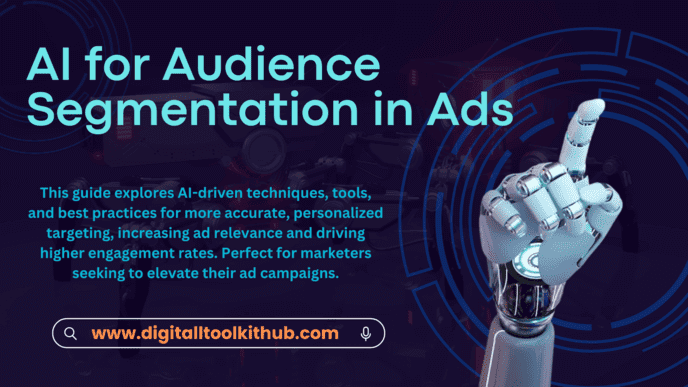
Leveraging AI for Audience Segmentation in Ads
Created on 6 November, 2024 • AI and Automation in Digital Marketing • 10 minutes read
This guide explores AI-driven techniques, tools, and best practices for more accurate, personalized targeting, increasing ad relevance and driving higher engagement rates. Perfect for marketers seeking to elevate their ad campaigns.
Audience segmentation has become critical to successful ad campaigns, helping marketers deliver highly relevant content to the right people at the right time. Traditional segmentation methods, while effective, often rely on broad categories. However, AI-driven audience segmentation is transforming this process by using data science and machine learning to predict behaviors, interests, and preferences on a granular level.
What Is AI-Driven Audience Segmentation?
AI-driven audience segmentation uses artificial intelligence algorithms to analyze vast datasets and categorize audiences based on their behaviors, interests, and demographics. Unlike traditional segmentation, which divides audiences into broad groups, AI can segment audiences at a much deeper, more personalized level.
Key Benefits of AI-Driven Audience Segmentation
- Precision Targeting: AI enables brands to deliver hyper-personalized messages, ensuring that ads resonate with each segment.
- Increased Engagement Rates: By focusing on the right audience, AI segmentation can boost click-through rates and ad interaction.
- Improved ROI: With better targeting, ad spend is more efficient, leading to higher return on investment (ROI).
- Real-Time Adaptation: AI can analyze data in real-time, making adjustments as audience behavior changes, optimizing campaigns dynamically.
How AI Transforms Audience Segmentation
Traditional audience segmentation often groups people by basic criteria like age, gender, or location. AI takes this further, enabling advanced methods that consider real-time data and behavioral insights.
Behavioral Segmentation
Behavioral segmentation leverages data on past actions, such as website visits, purchase history, and search activity. AI tools can automatically identify patterns and segment users based on predicted behaviors, tailoring ads for each unique user.
Psychographic Segmentation
AI can analyze psychographic data, considering values, interests, and lifestyles to create deeper profiles. This approach goes beyond demographics to understand what truly motivates each audience segment.
Predictive Analytics for Audience Insights
Predictive analytics uses historical data to forecast future actions. For instance, if a customer has previously purchased running shoes, AI might predict their interest in fitness gear, enabling highly targeted ads that align with future needs.
Best AI Tools for Audience Segmentation in Advertising
Many tools today harness AI to enhance audience segmentation in ad campaigns. Here are some popular ones:
- Google Analytics 360 : Uses machine learning to identify behavioral patterns and segment users based on website interactions.
- Facebook Lookalike Audiences : Employs AI to find audiences similar to existing customers, expanding reach with precision.
- Adobe Audience Manager : Helps create dynamic audience segments with real-time data for cross-channel campaigns.
- HubSpot: Uses AI to create detailed audience personas, optimizing ad targeting.
Case Studies of Successful AI-Driven Audience Segmentation
AI-driven audience segmentation has been widely adopted by brands across industries, yielding impressive results. Here are a few notable examples:
Example 1 - E-commerce Brand Boosts Conversions
An online retailer used AI to segment audiences based on browsing history, previous purchases, and demographic data. By tailoring ads to each segment, they saw a 30% increase in conversions.
Example 2 - Streaming Service Enhances User Retention
A streaming service used AI-driven segmentation to deliver personalized content recommendations. This boosted engagement rates and reduced churn by 20%.
Example 3 - Financial Services Optimize Ad Spend
A financial services company applied AI to identify high-value segments for investment products. By focusing on targeted messaging, they achieved a 15% increase in ROI.
Implementing AI in Your Audience Segmentation Strategy
Implementing AI for audience segmentation requires thoughtful integration into your existing digital marketing framework. Here are the steps to start:
- Identify Goals: Define what you aim to achieve with AI-driven segmentation (e.g., higher engagement, lower CPA).
- Choose the Right Tool: Based on your budget and audience, select an AI platform suited to your needs.
- Set Up Data Collection: Use CRM systems, social media, and web analytics tools to gather audience data.
- Analyze and Iterate: Use AI tools to continuously assess and refine segmentation strategies based on campaign results.
Key Challenges and Ethical Considerations
While AI-driven audience segmentation offers many benefits, it also presents challenges and ethical concerns:
Data Privacy Issues
AI-based segmentation relies heavily on user data. Ensure compliance with privacy laws like GDPR to protect consumer rights.
Bias in AI Algorithms
AI algorithms can sometimes exhibit bias, leading to unfair targeting practices. Regular audits can help ensure fair and equitable segmentation.
High Cost of AI Integration
Advanced AI tools can be costly, which may be a barrier for small businesses. Consider starting with scalable AI options that fit your budget.
AI-driven audience segmentation is transforming how marketers connect with their target audience. By leveraging AI for behavioral, psychographic, and predictive segmentation, brands can create highly personalized campaigns, maximize engagement, and optimize ad spend. As AI technology advances, adopting these strategies will be crucial to staying competitive in the digital marketing landscape.